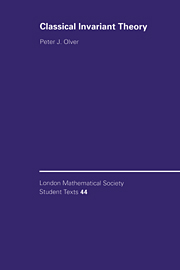Book contents
- Frontmatter
- Contents
- Introduction
- 1 Prelude — Quadratic Polynomials and Quadratic Forms
- 2 Basic Invariant Theory for Binary Forms
- 3 Groups and Transformations
- 4 Representations and Invariants
- 5 Transvectants
- 6 Symbolic Methods
- 7 Graphical Methods
- 8 Lie Groups and Moving Frames
- 9 Infinitesimal Methods
- 10 Multivariate Polynomials
- References
- Author Index
- Subiect Index
7 - Graphical Methods
Published online by Cambridge University Press: 08 January 2010
- Frontmatter
- Contents
- Introduction
- 1 Prelude — Quadratic Polynomials and Quadratic Forms
- 2 Basic Invariant Theory for Binary Forms
- 3 Groups and Transformations
- 4 Representations and Invariants
- 5 Transvectants
- 6 Symbolic Methods
- 7 Graphical Methods
- 8 Lie Groups and Moving Frames
- 9 Infinitesimal Methods
- 10 Multivariate Polynomials
- References
- Author Index
- Subiect Index
Summary
One of the barriers awaiting any serious student of the classical theory is the sheer algebraic complexity of many of the constructions. With a view to rendering these complicated manipulations more manageable, not to mention better visualized, Clifford, began developing a graphical method for the description of the invariants and covariants of binary forms, although he died before publishing his findings to any significant extent. Contemporaneously, Sylvester, unveiled his “algebro-chemical theory”, the aim of which was to apply the methods of classical invariant theory to the then rapidly developing science of molecular chemistry. Sylvester's theory was never taken very seriously by chemists, and not developed any further by mathematicians, and soon succumbed to a perhaps well-deserved death. The present graphical treatment of invariant theory, based on results of C. Shakiban and the author, is closest to the version developed by Kempe, which builds on Clifford's posthumous notes.
Although Sylvester envisioned his theory as the future of chemistry, it is Clifford's graph theory that, with one slight but important modification, could have become an important tool in computational invariant theory. The correct framework for the algebro-chemical theory is to use “linear combinations of” digraphs or “directed molecules” as the fundamental objects. One can ascribe both a graph theoretical as well as a chemical interpretation to these objects; both are useful for motivating the method. The fundamental syzygies then translate into certain operations which can be performed on digraphs or, equivalently, certain allowable reactions which can occur among directed molecules.
- Type
- Chapter
- Information
- Classical Invariant Theory , pp. 128 - 149Publisher: Cambridge University PressPrint publication year: 1999



